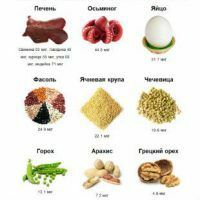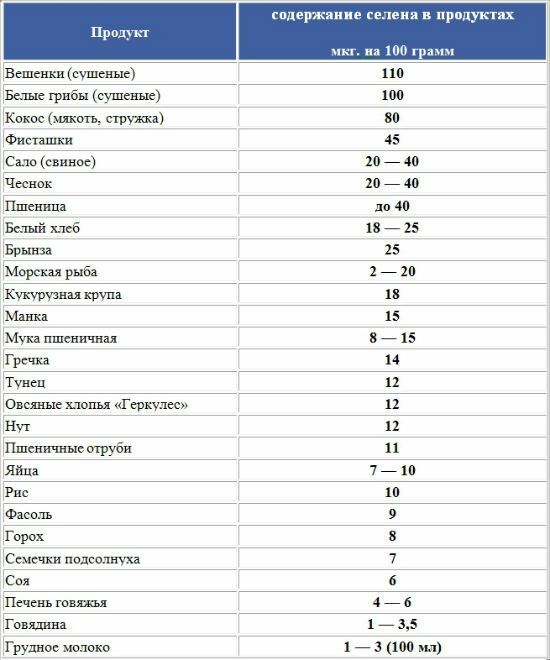
Selenium was discovered by the famous chemist-researcher Ions Berzelius in 1817.This microelement was named after the mysterious companion of our planet - the Moon. For many years, selenium belonged to the class of toxic substances, and only in the 60s of the last century the role of selenium for human health was revised. Today selenium is an active agent for the prevention of cancer and the treatment of cardiovascular diseases. Selenium also has the status of a mineral of longevity. This trace element is not synthesized by human organs. Consider in more detail the functions of selenium in the human body, as well as food that is the source of this trace element.
- Functions of selenium in the human body
- Daily norm of selenium
- Symptoms of deficiency and overdose of selenium
- Selenium sources
Functions of selenium in the human body
Selenium accumulates in the kidneys, organs of the reproductive system, liver, heart, bone marrow, lungs, skin. In the human body, this trace element performs the following functions:
- enhances immunity;
- is involved in the formation of red blood cells;
- is a potent antioxidant;
- activates the functions of vitamin E;
- stimulates the production of hemoglobin;
- reduces the risk of developing muscular dystrophy of the heart;
- suspends the development of malignant neoplasms;
- activates metabolic reactions in the body;
- protects the body's systems from the effects of heavy metals;
- improves reproductive function in men;
- restores the work of the central nervous system and endocrine system;
- reduces inflammation;
- improves skin condition.
Selenium is a constituent of many hormones, proteins and enzymes that regulate the basic processes of vital activity in the body.
to contents ^Daily norm of selenium
For an adult, the daily requirement of selenium is in the range of 10 to 100 μg. This microelement, with the help of vitamins E and C, is fully absorbed by the human body. Flour products, sweets, semi-finished products and canned foods in the diet prevent the absorption of selenium. To the deficiency of selenium, the administration of certain medications also results.
It is recommended to increase the daily norm of selenium for athletes, future mothers, smokers and people who are systematically experiencing strong physical activity.
to table of contents ^Symptoms of deficiency and overdose of selenium
If the body receives less than 5 μg of selenium per day, the following symptoms of deficiency of this mineral appear in the body:
- muscle weakness;
- chronic fatigue;
- stress stress;
- hair loss;
- formation on the skin of ulcers;
- increase in cholesterol;
- weakened immune responses;
- menstrual cycle disorder;
- decreased visual acuity.
Deficiency of selenium leads to impaired liver function and pancreatic function, and also destabilizes the work of the reproductive organs in men. Deficiency of selenium is especially dangerous for newborns. If an infant feeds on only milk mixtures and does not get bioavailable selenium, this can provoke the development of serious ailments in the baby, up to a lethal outcome.
Insufficient amount of selenium during pregnancy can cause a woman premature birth and development of toxicosis. The risk group also includes elderly people, as the amount of selenium decreases every year in their bodies.
For a human, a daily dose of selenium of 5 mg is considered toxic. The main signs of an overdose of this microelement are:
- permanent skin peeling;
- nail brittleness;
- increased tooth sensitivity;
- nausea, which is accompanied by vomiting;
- hair loss;
- smell of garlic from the mouth;
- mental disorder;
- development of bronchopneumonia;
- hepatic dysfunction.
Selenium in a dosed amount serves as an anticarcinogen. But with uncontrolled consumption of selenium can cause the active growth of cancer cells. To determine the necessary norm of selenium for your body, it is recommended to undergo a medical examination in the clinic.
Selenium sources
It has been experimentally proved that 90% of selenium enters the human body with products and only 10% - with water. Most of the selenium is absorbed in the digestive tract.
The main sources of selenium are the following food products:

The Brazilian nut is considered to be the record holder for selenium.100 g of nuts contain 1915 μg of selenium. If you eat one or two Brazil nuts per day, you can fully provide the body with this micronutrient.
The daily norm of selenium can also be obtained with dishes cooked on the basis of corn. For example, for breakfast you can eat 100 g of cornflakes with milk, but without the addition of sugar.
Selenium is rich in garlic. If you eat a few cleaned cloves of garlic for dinner, squeezed water, you provide your body with a daily dose of selenium, as well as enhance the body's immune responses.
The amount of selenium in food is reduced during its long thermal and heat treatment. So, in cans, concentrates and semifinished products, selenium is several times less than in raw food. This mineral is not digested with simple carbohydrates - sweets and confectionery.
The amount of selenium in vegetables and cereals directly depends on its concentration in the soil, where these crops were grown.
You can get a source of easily digestible selenium form at home. To do this, grow a small amount of wheat grains in the saucer. As a result, you will receive a biologically active additive, which will contain not only selenium, but other important macroelements and vitamins for the organism.
For the prevention of selenium deficiency, it is recommended to consume daily 2 g of live beer yeast dissolved in warm water.
You can also prepare the original yeast pâté.For its preparation, one large onion should be put out in a deep container with a tablespoon of vegetable oil and 40 ml of water. After the onion is clear and soft, you need to add 50 g of baker's yeast to it and mix it gently. Then, drive in two chicken proteins and stir the mass until thick. In pate from yeast, you can add chopped greens and a little sea salt. This dish will remove from the body toxic compounds, and also provide you with a daily norm of selenium.
You can replenish the deficit of selenium not only with food. Today, the pharmaceutical market offers a wide range of dietary supplements, which include selenium. Preparations of selenium should be taken in the morning and with minimal doses of 40 micrograms per day. The course of taking supplements with selenium is two to three months.

Hello, tell me what to do if an overdose of selenium supplements., The body is covered with red?